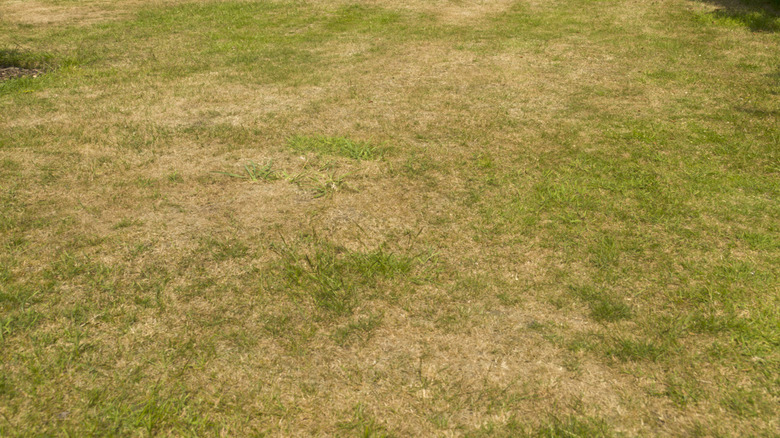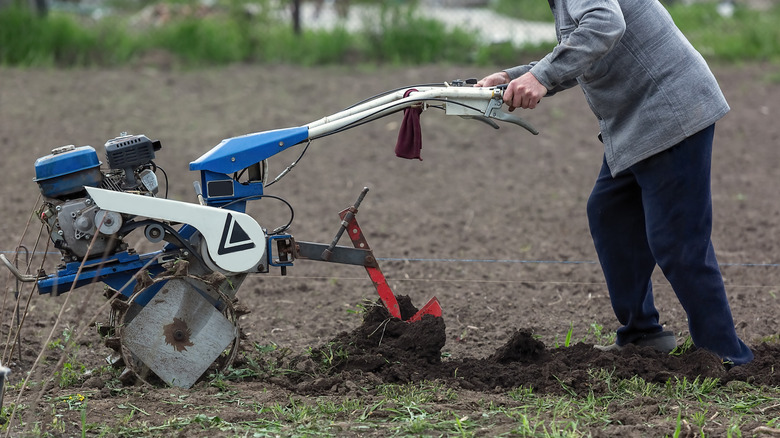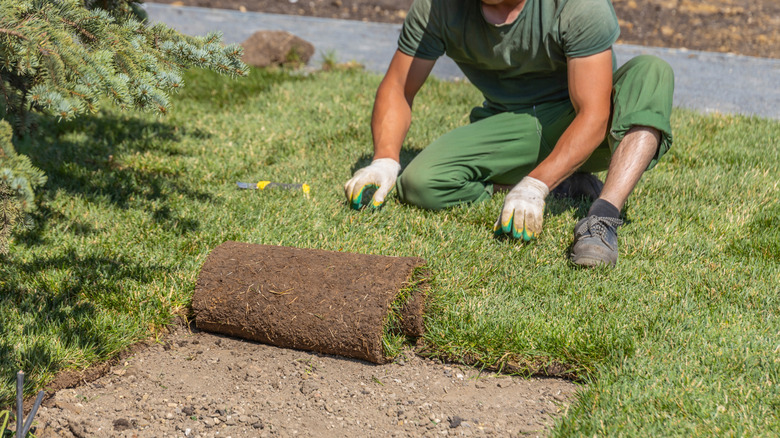How To Get Rid Of Your Old Dead Lawn And Grow A Whole New Grass Type
If you have patchy grass in your yard, you may attempt to use the overseeding technique on your lawn to try to gain more growth and thickness. If your yard is still looking more brown than ever and you simply aren't getting the results that you want, you might wonder whether it's time to put in a new lawn by digging out the old grass. Because it can be a pricey and time-consuming process to take out old grass and plant new, you might question whether this is a job you want to tackle yourself. We reached out to Bryan Clayton, CEO at GreenPal, for trustworthy advice.
Before you decide to give up on your existing lawn and start over, Clayton tells House Digest in an exclusive interview that it's important to take an assessment of your existing yard. Not everyone who has problems with weeds and patchy grass needs to start over, especially considering the amount of work that goes into the process. "For general lawn cleanup — like tackling weeds such as dandelions and clover — you don't need to start from scratch," he says. "Use a selective herbicide to kill the weeds, aerate the lawn, and overseed."
If you're committed to changing grass types, Clayton shares the steps on how to do it right, whether you're going from Bermuda to fescue or fescue to Bermuda. "I can tell you that switching lawn types is no small job, so get ready to dig in if you're serious about it," he says. "Here's what you need to know."
Out with the old
According to Bryan Clayton, the first step is to kill the existing grass with a herbicide. Some types of grass will take more effort to kill off than others. For example, he says Bermuda is a hardy grass that's difficult to kill. "Use a non-selective herbicide to spray the entire lawn. You'll need to spray it three times over three weeks to make sure the Bermuda is completely dead," he says in an exclusive interview with House Digest. "If you skip steps or don't spray enough, Bermuda will come back and choke out your new [grass]. Take the time to spray multiple times."
Next, you should mow it as close to the ground as possible. Because the proper length to mow a lawn is around 3 inches, you'll have to drop the mower deck to its shortest setting, which often is as low as 1 inch. You'll then want to use a rototiller to completely dig up the grass — roots and all. Tilling also serves to prepare the soil for the new seed or sod. "Not tilling or leveling the ground will lead to poor seed germination or lumpy sod," he says.
In with the new
To start your new lawn, you'll first need to decide what to plant. "Pick a type [of grass] that fits your climate and sun/shade needs," Bryan Clayton says. "Bermuda loves sun, while tall fescue can handle a mix of sun and shade." Then you can pick up where you left off with preparing your soil. "After rototilling, make sure you add some starter fertilizer to give the new seed or sod a strong start," he says.
When planting the new grass, you'll have to decide on using seed or sod on the lawn. The application technique you should choose depends on the type of grass you want to plant. "If you're planting tall fescue, hydroseeding works well, or you can lay sod for faster results," Clayton tells House Digest in an exclusive interview. For Bermuda grass, he says to plant "sod or sprigs. Don't bother with Bermuda seed — it doesn't work well and rarely establishes properly."
After planting, setting up the proper watering schedule is important. Clayton says you should water seed lightly two or three times per day until it germinates, while watering sod should be done less often but more deeply. "Watering is critical, but don't overdo it," he says. "Too much water causes fungus and shallow roots." Although it can be a lot of work to establish your new lawn, it's quite rewarding when you see that the final product is established enough for its first mowing. "Switching lawn types is a big job, but if you follow these steps, you'll get the lush, healthy lawn you're after," Clayton says.


